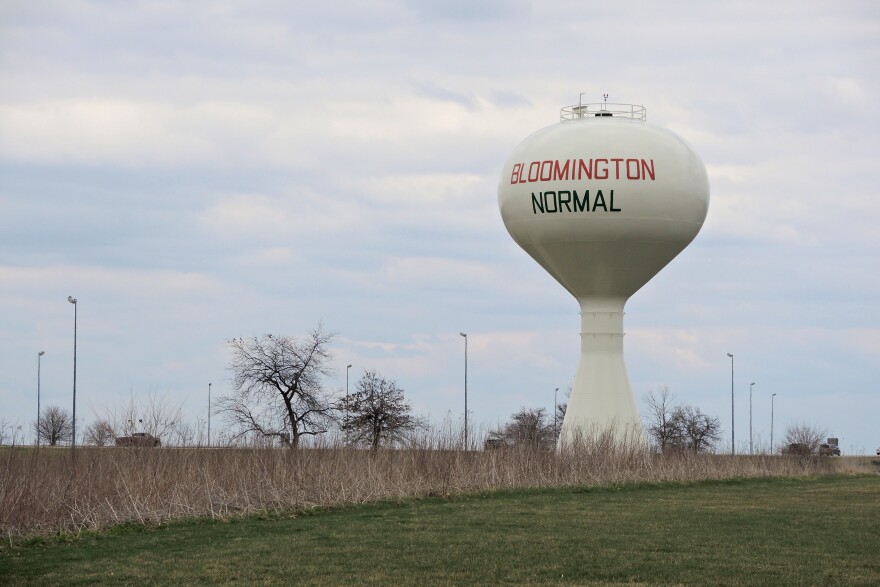The recently approved federal infrastructure bill will pump $1 trillion into projects ranging from roads and bridges to broadband and public transportation.
Government leaders in Bloomington-Normal are getting their wish lists ready. Some projects have been years in the making. Others are aspirational.
First on Normal Mayor Chris Koos' list is wastewater. The Bloomington-Normal Water Reclamation District (BNWRD) is entering the design phase of a major project that could cost as much as $180 million.
Upgrades to its two treatment plants will put BNWRD in compliance with federal phosphorous emissions rules by 2035. The project was on a short list of proposals that economic developers in McLean County took to Washington last winter as part of the so-called One Voice delegation.
Koos said he hopes the billions the federal government plans to pour into water quality and treatment will unlock funding for the project.
“Traditionally, the federal government hasn’t involved themselves in those kinds of issues (such as) water infrastructure, but now they are starting to become aware it is a pressing issue,” Koos said. “I certainly understand water quality is a driving issue.”
Reclamation district director Randy Stein said he believes drinking water could get greater attention in this funding bill than water treatment “because there’s a number of problems similar to what occurred in Flint, Michigan,” Stein said. “There’s a big move to remove lead pipes.”
Stein added BNWRD has been in the process of seeking forgivable loans through the state, and it's not clear how much help the district will get.
“State and federal help on a loan that size is variable,” said Stein, adding BNWRD has enough funding to cover about 65% of the project costs through financing.
Bloomington
Bloomington City Manager Tim Gleason said the city hopes the infrastructure bill will help it get the last $5 million it needs to complete the final piece of its Hamilton Road connection (from Bunn to Commerce) that's been two decades in the making.
“We just have to believe with the additional dollars, that’s going to give us an even stronger chance to be awarded,” Gleason said.
Gleason said the city also will explore how it can help the city improve its water and sewer systems. The city's under-the-ground infrastructure has become a focal point following flooding in late June that filled hundreds of homes with stormwater and sewage. Gleason said the city already was working its long-range water and sewer master plans.
“That’s an area we are exploring, what does this mean? What’s opened up with this funding? The topic of infrastructure specific to water and sewer has been one that we’ve had well before the storm in June,” he said.
Public transportation
The infrastructure bill includes $66 billion in guaranteed money for rail, mostly passenger rail like Amtrak. That could rise to over $100 billion over the next five years, depending on what policymakers decide to appropriate.
That’s the most money put into passenger trains since the founding of Amtrak, said Sean Jeans-Gail, vice president of policy and government affairs for the Rail Passengers Association.
“It really is a pivotal moment in passenger rail in the long, storied history of trains in America,” he said.
For communities like Bloomington-Normal already served by Amtrak, Jeans-Gail said expect to see increased frequency.
“So that it’s something where you don’t have to plan ahead really to use. You can just show up at the station and know within half an hour you’re going to be able to get on a train and go to Chicago or St. Louis and, once there, they’ll be another connection to take you to your final destination,” he said.
Jeans-Gail said a challenge will be to connect the dots between the 15-year planning map that Amtrak put out last summer with the more ambitious 40-year Midwest Regional Rail Plan released this fall by the Federal Railroad Administration.
As for new connections, there's no shortage of ideas.
“Right now, you can’t get from Normal to Madison, Wis., but that’s certainly a near-term goal for the Midwestern regional rail network,” Jeans-Gail said.
Koos says he hopes the infrastructure bill will lead to increased frequency for several existing Amtrak routes that go through Bloomington-Normal,and could mean additional funding for Connect Transit to expand its bus service.
“The stronger the public transit is, the more convenient it is, the more people are going to use it,” Koos said. “Our local transit district has done a great job of leveraging federal and state dollars to improve the system and this may give them yet another boost.”
Connect Transit has secured millions in federal funding for a planned bus transfer center in downtown Bloomington.
EV technology
Mike Raikes, president of McLean County Building and Construction Trades, said traditional infrastructure projects like roads and bridges will see a big boost from the federal money delivered by the bill, but he said McLean County stands to see even greater benefits thanks to projects like the construction of EV charging stations.
The federal infrastructure bill will pump $7.5 billion into the electric vehicle industry.
“A huge advantage of this bill is going to be electric vehicle infrastructure with what we have in our backyard in Rivian,” Raikes said.
Raikes said interest in skilled trade has increased since Rivian set up shop in Normal. Apprenticeships have tripled in the past three years. That’s helped to stave off the kind of workforce shortage problems that have cropped up in other parts of the country.
So far, Raikes said, local workforce demands are being met. But he said there’s still a need to scale up training and apprenticeship programs as demand continues to grow.
Cost
The infrastructure bill will be paid in part with unspent COVID relief funds. The Congressional Budget Office (CBO) projects the bill will add about $256 billion in deficit spending over the next decade.
Central Illinois congressmen Rodney Davis, R-Taylorville, and Darin LaHood, R-Dunlap, voted against the bill. Davis called it “reckless, multi-trillion-dollar tax-and-spending legislation.”




